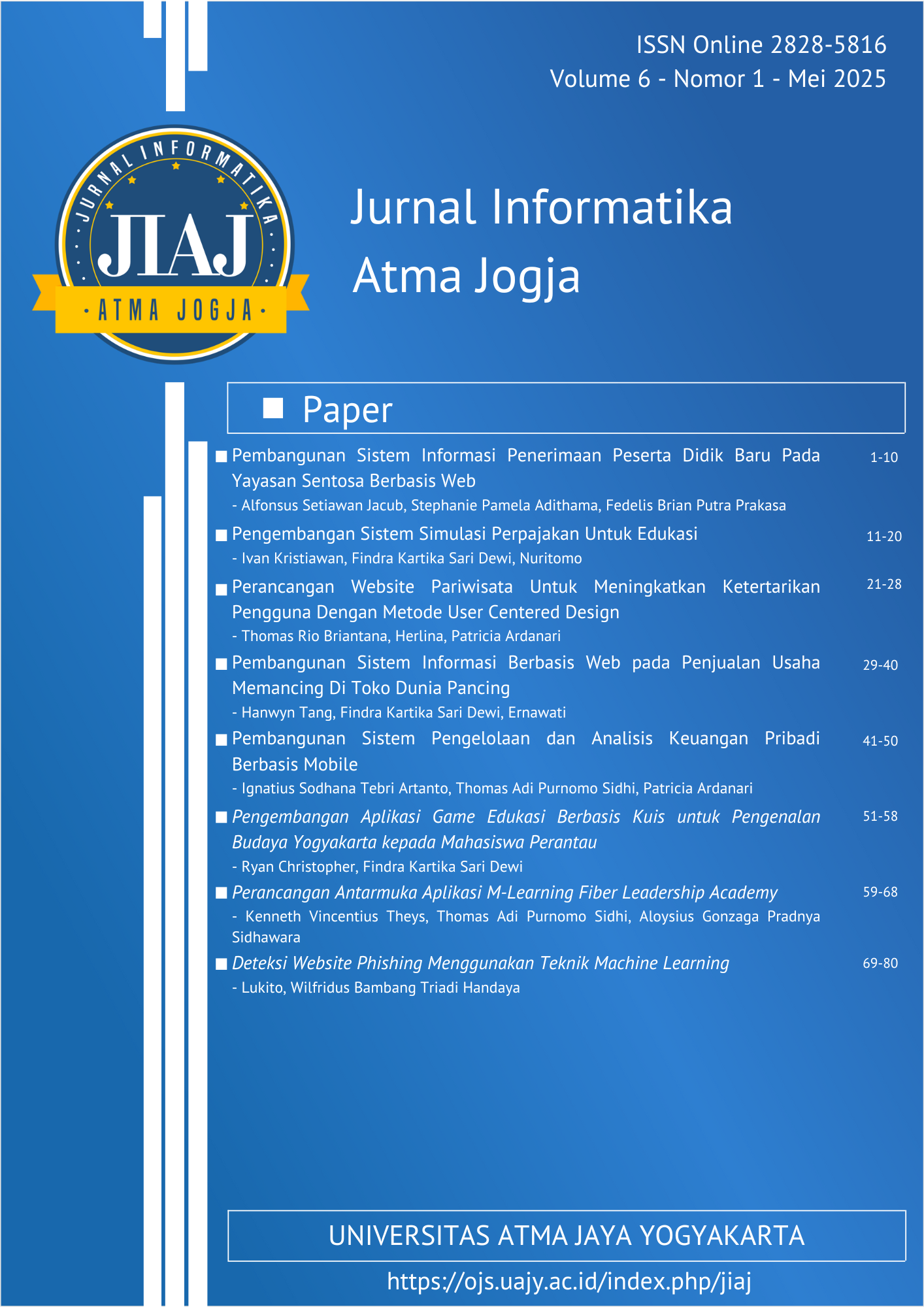Deteksi Website Phishing Menggunakan Teknik Machine Learning
DOI:
https://doi.org/10.24002/jiaj.v6i1.11538Keywords:
Machine Learning, Supervised Learning, PhishingAbstract
Phishing merupakan teknik penipuan yang memanfaatkan penyamaran sebagai entitas tepercaya untuk mencuri data sensitif. Metode deteksi berbasis machine learning, seperti XGBoost, Random Forest, dan Decision Tree, efektif dalam mengenali pola website phishing. Hasil penelitian menunjukkan bahwa XGBoost dengan hyperparameter tuning memberikan akurasi tertinggi, yaitu 96%. Model ini kemudian diimplementasikan dalam web service menggunakan Flask atau FastAPI, sehingga pengguna dapat memeriksa URL secara real-time. Sistem juga dilengkapi mekanisme ekstraksi fitur, termasuk analisis URL, domain age, dan konten halaman, serta pelabelan otomatis untuk memudahkan pelatihan ulang model. Selain itu, integrasi dengan bot Telegram memperluas aksesibilitas, karena pengguna dapat melakukan deteksi phishing kapan saja melalui pesan instan tanpa batasan lokasi atau perangkat.
References
[1] S. Kurniawan, “Phising: Pengertian, Cara Kerja dan Langkah Mengatasinya,” Niagahoster Blog, May 22, 2023. https://www.niagahoster.co.id/blog/mengatasi-phishing/
[2] E. Dzuba, “Introducing Cloudflare’s 2023 phishing threats report,” The Cloudflare Blog, Oct. 26, 2023. https://blog.cloudflare.com/2023-phishing-report/
[3] E. Sangra, R. Agrawal, P. R. Gundalwar, K. Sharma, D. Bangri, and D. Nandi, "Malicious Website Detection Using Random Forest and Pearson Correlation for Effective Feature Selection," International Journal of Advanced Computer Science and Applications (IJACSA), vol. 15, no. 8, pp. 772-780, 2024, http://dx.doi.org/10.14569/IJACSA.2024.0150876
[4] K. Adane, Berhanu Beyene, and Mohammed Abebe, “ML and DL-based Phishing Website Detection: The Effects of Varied Size Datasets and Informative Feature Selection Techniques”, Journal of Artificial Intelligence and Technology, vol. 4, no. 1, pp. 18–30, Sep. 2023.
[5] M. Bahaghighat, M. Ghasemi, and F. Ozen, "A high-accuracy phishing website detection method based on machine learning," Journal of Information Security and Applications, vol. 77, p. 103553, 2023. Available: https://doi.org/10.1016/j.jisa.2023.103553.
[6] P. and Dhandayudam, P., “An Optimized Bagging Learning with Ensemble Feature Selection Method for URL Phishing Detection”, Journal of Electrical Engineering & Technology, vol. 19, no. 3, Springer, pp. 1881–1889, 2023. doi:10.1007/s42835-023-01680-z.
[7] D. Komalasari, T. B. Kurniawan, D. A. Dewi, M. Z. Zakaria, Z. Abdullah, and A. Alanda, “Phishing Domain Detection Using Machine Learning Algorithms”, Int. J. Adv. Sci. Eng. Inf. Technol., vol. 15, no. 1, pp. 318–327, Feb. 2025. doi: https://doi.org/10.18517/ijaseit.15.1.12553
[8] A. F. Mahmud and S. Wirawan, "Deteksi Phishing Website menggunakan Machine Learning Metode Klasifikasi," Sistemasi: Jurnal Sistem Informasi, vol. 13, no. 4, pp. 1368-1380, 2024, doi: https://doi.org/10.32520/stmsi.v13i4.3456.
[9] Y. Muliono, M. A. Ma'ruf, and Z. M. Azzahra, "Phishing Site Detection Classification Model Using Machine Learning Approach," Jurnal EMACS (Engineering, Mathematics and Computer Science), vol. 5, no. 2, pp. 63-67, May 2023, doi: 10.21512/emacsjournal.v5i2.995163.
[10] S. K. Ahmad, B. A. Dapshima, and Y. C. Essa, "Detection of Phishing Attacks Using Machine Learning Techniques," International Research Journal of Modernization in Engineering, Technology and Science, vol. 6, no. 7, pp. 1166, July 2024, doi: 10.56726/IRJMETS60054.
[11] N. S. Zaini, D. Stiawan, M. F. Ab Razak, A. Firdaus, W. I. S. Wan Din, S. Kasim, and T. Sutikno, "Phishing Detection System Using Machine Learning Classifiers," Indonesian Journal of Electrical Engineering and Computer Science, vol. 17, no. 3, pp. 1165-1171, Mar. 2020, doi: 10.11591/ijeecs.v17.i3.pp1165-1171.
[12] V. Borate, D. Adsul, M. Dhakane, M. Gawade, M. Ghodake, and M. Jadhav, "A Comprehensive Review of Phishing Attack Detection Using Machine Learning Techniques," International Journal of Advanced Research in Science Communication and Technology, vol. 4, pp. 435-441, 2024, doi: 10.48175/IJARSCT-19963.
[13] G. Harinahalli Lokesh and G. BoreGowda, "Phishing Website Detection Based on Effective Machine Learning Approach," Journal of Cyber Security Technology, vol. 5, no. 1, pp. 1-14, 2020, doi: 10.1080/23742917.2020.1813396.
[14] A. Hannousse and S. Yahiouche, "Towards Benchmark Datasets for Machine Learning Based Website Phishing Detection: An Experimental Study," Engineering Applications of Artificial Intelligence, vol. 104, 2021, Art. no. 104347, doi: 10.1016/j.engappai.2021.104347.
[15] G. Vrbančič, I. Fister, and V. Podgorelec, “Datasets for phishing websites detection,” Data in Brief, vol. 33, p. 106438, Oct. 2020, doi: 10.1016/j.dib.2020.106438.
Downloads
Published
Issue
Section
License

This work is licensed under a Creative Commons Attribution-ShareAlike 4.0 International License.
Copyright of this journal is assigned to Jurnal Informatika Atma Jogja as the journal publisher by the knowledge of author, whilst the moral right of the publication belongs to author. Every printed and electronic publications are open access for educational purposes, research, and library. The editorial board is not responsible for copyright violation to the other than them aims mentioned before. The reproduction of any part of this journal (printed or online) will be allowed only with a written permission from Jurnal Informatika Atma Jogja .






